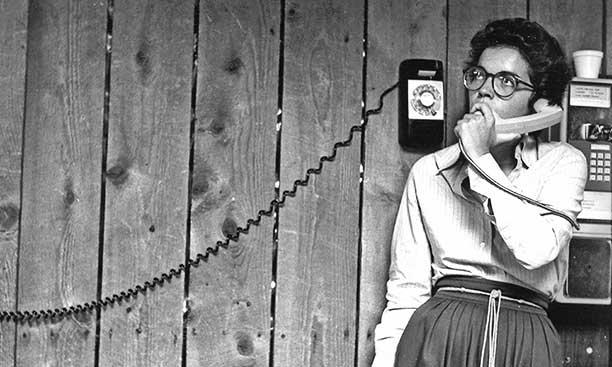
Retired PBS news anchor Jim Lehrer has won his profession’s top honors and moderated a record-breaking 12 presidential debates. But on a recent visit to the University of Missouri, where I teach, he reminisced with palpable pride about his roots in local journalism.
“My senior year, first semester, I covered the police beat,” Lehrer said, recalling his days as a rookie reporter for the Columbia Missourian, the community newspaper operated by student reporters and professor editors from Mizzou’s School of Journalism. “And then, second semester, I covered the courthouse — the Boone County courthouse.”
The path Lehrer took to success was, until very recently, a reliable and well-worn one. I know because I followed it myself. When I graduated from Princeton — my head full of Yeats and Chaucer and Professor Walter Murphy’s near-poetic renderings of constitutional law, my portfolio filled with clips about the existential threat to the Dinky (some things never change) — I wanted to head straight to the Big Top.
There is nothing like the prospect of running into a news source in the grocery store aisle to make you a stickler for accuracy and fairness.
But this was just after Watergate, and there were many more-experienced wanna-be Woodsteins in line ahead of me. There were no rookie reporter jobs in Washington or New York that would give me the experience I wanted, or leave me with the money I needed to repay student loans.
So, home I went to The Pittsburgh Press, where I wrote about golden wedding anniversaries, local deaths, and zoning board meetings. I learned that poetry and erudition provided a good foundation but that, in newspaper writing, concision and precision were the top priority. Eventually, after I had proven myself, I got assigned to city council meetings and state legislative races. By the time I did make it to Washington, I already knew many of the members of Congress on my beat because I had covered them as they were climbing the political ladder.
For my students at Lehrer’s alma mater, the path to the national stage is much swifter and more direct. And that is a big problem. For them — but even more, for the rest of us.
The economic realities that drove me back to Pittsburgh when I got out of Princeton have changed utterly. Today’s digitally driven, winner-take-all economy is sending aspiring young journalists in the opposite direction. As Penny Abernathy of the University of North Carolina has painstakingly documented in her research on the rise of news deserts — communities that lack a local news source — one in five of the nation’s newspapers has folded over the last 15 years. Meanwhile, according to a recent report by the Pew Research Center, one in five of today’s journalism jobs is located in New York, Washington, or Los Angeles.
This means we have disproportionate coverage of the capitals of money, celebrity, and politics, and far less coverage of state capitals, local government, and schools — the power centers that have the most immediate impact on people’s lives. It also means we have abandoned our observation posts in regions of the country that, thanks to the way the Constitution apportions votes in the Senate and Electoral College, have disproportionate political power. Hence, the surprise of the 2016 election.
Aspiring journalists graduating college today are starting out where Jim Lehrer and I once aspired to be. In the run-up to the 2012 presidential campaign, I supervised a group of fresh-out-of-college grads who served as “embeds,” covering the presidential candidates for National Journal and CBS News.
Those young reporters, and the ones I’m preparing for newsrooms now, are smart, hard-working, and technically far more savvy than I will ever be. But I worry about the sheriff’s race and the school board meetings that they’re not covering. I worry about what they’re missing by not having to face the human consequences of their work in the awkwardly intimate way that only local reporters do. There is nothing like the prospect of running into a news source in the grocery store aisle to make you a stickler for accuracy and fairness.
I worry even more about what the absence of community journalism, and the knowledge that it creates — both for the journalists and the citizens — means for civil society. I have covered politics for more than 40 years, and I am convinced that one of the reasons for the stunning levels of free-floating anger in our society today is frustration. People do not know where the levers of power are.
Based on today’s news, you might be forgiven for thinking there’s only one elected official in America. The only way members of Congress get any ink or air time is if they opine on impeaching him. State lawmakers? City officials? Fuggedaboutit.
There are two reasons for this, and neither of them has anything to do with lazy reporters.
The first was summed up well by a great comic philosopher: “We have met the enemy and he is us,” cartoonist Walt Kelly’s Pogo told us.
Back in the day when I was getting my start at The Pittsburgh Press, we knew in our guts that the celebrity divorce story would get more eyeballs than the state Senate hearing on secondary-education budgets. So the divorce story went on page one, below the fold. The school budget story would be back in the B section. But it would be in there. Today, almost every newsroom manager has access to a digital dashboard such as Chartbeat. She knows exactly how many of you are clicking on that divorce story and how many bothered to check out the school budget news. Is there any wonder that the salacious stuff is leading the websites?
The second part of the problem, the reason that all too often the school budget story isn’t even getting covered these days, has to do with the bottom line. The 25 cents that used to buy you a local paper didn’t come close to covering the cost of what we newsroom denizens like to call “the daily miracle.” Until the dawn of the internet, your reading pleasure was subsidized by advertising. And the most important source of ad revenue at most newspapers wasn’t the full-page ads from your local department store or car dealer. Classified advertising — those columns of agate print offering used lawnmowers, stray kitties, and rms w/vus — underwrote untold amounts of public-service journalism. The reason most editors went ahead and sent a reporter to the school budget meeting, even though they suspected a lot of you might not read past the headline, is that newspapers were so flush with cash from all those ads they could afford to be civic-minded.
Hello eBay, Craigslist, and microtargeted advertising via Google and Facebook. Goodbye copy desk, statehouse reporter, and public-service journalism.
As you will read elsewhere in these pages, there are plenty of hard-working innovators out there trying to fill the gaps in our information safety net. What none of them have yet figured out is how to pay for public-service journalism in a digital age. Revenues from digital ads are minuscule compared to what print paid; philanthropists are fickle; ideafests and lecture tours can generate new cash streams, but how many tickets to those can you sell, particularly in small towns in flyover country?
Maybe this is not a matter of a marketing genius coming up with a brilliant new idea for making people part with their money. Maybe funding journalism isn’t an entrepreneurial problem but a public-policy problem.
Two states, New Jersey and Virginia, recently decided to use some of the windfall they received from the auction of the public spectrum — airwaves public TV stations used for analog broadcasting before the switch to digital — to fund community journalism. In Congress, some lawmakers are pushing legislation that would give newspaper publishers a temporary antitrust exemption to negotiate better deals with the online internet platforms that deliver the news many of them spent the last two decades not paying for.
There’s some natural resistance to this sort of public subsidy for publishers who so recently were community fat cats. Do we really want to reward people who were too complacent to jump on the internet bandwagon until it got too late to capture some of those revenues for news? On the other hand, as a country we have bailed out plenty of other industries that were a lot less important to democracy.
And then there’s the demand side of the equation: what I would call solving the Pogo problem.
Right now, people who rely on social media for news — and a recent Pew Research Center report found that more Americans get news from social media these days than newspapers — are being exposed to more confirmation bias, filter bubbles, and algorithmic and neurological manipulation than they are to ideas and opinions that might cause them to reconsider their own. It’s the intellectual equivalent of three daily servings of Doritos, Cheetos, and Hostess Ho Hos: immediately gratifying but devoid of the kind of nutrition anyone needs for long-term existence.
Saving local news may be partly a matter of educating the public to care enough to pay for it. Just as we educated ourselves to wear seatbelts, stop smoking, and swap the high-cholesterol lunches for gym memberships, we need to begin consciously adding whole grains back into our information diet. That means teaching news literacy — in schools, in universities, at Chambers of Commerce and Rotary Clubs and in retirement homes.
In an age when everyone with a smart phone is a publisher, a little dose of Journalism 101 would be good for everybody. Reporters know how to seek the information they need, and edit out the stuff that’s wrong or extraneous. They know how to find reliable sources and avoid the other kind.
Journalism isn’t just for journalists anymore. Own it, America. Or lose the democracy that depends on it.








2 Responses
Charles Saydah p'99
5 Years AgoHollowed-Out News Business
Kathy Kiely ’77’s observation about the concentration of journalism jobs in just three places (“The Future of Journalism: Our Towns,” Jan. 8), striking as it is, misses an equally disheartening fact of life: Even in those places, the number of jobs has dwindled considerably, due primarily to circulation losses. The Los Angeles Times, one of the nation’s great papers, is a shell of what it was in its halcyon days when it reached 1.2 million readers — barely 700,000 print readers the last time I looked. It’s still a great paper. But just a look at the repetition of bylines on significant stories suggests the constraints operating on the staff that remains.
The Daily News in New York, once the paper with the largest circulation in the United States with some 2 million readers a day, now puts papers in the hands of 200,000. Sure, both papers boast considerable online reach. But, as Kiely points out, that doesn’t pay the bills the way print used to, even as expensive as print is.
Norman Ravitch *62
6 Years AgoWhat Do They Read?
In the deli I frequent the locals are reading, I make it my business to notice, the sports page, the crime page, and of course the funnies. This is journalism for the masses.
I grew up in a home that read the NY Times (no comics) and perhaps for fun the Daily Worker! Also no comics, except everything in the Daily Worker was funny.